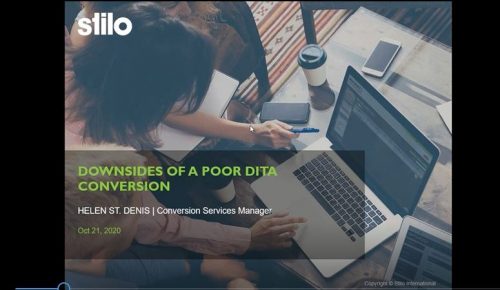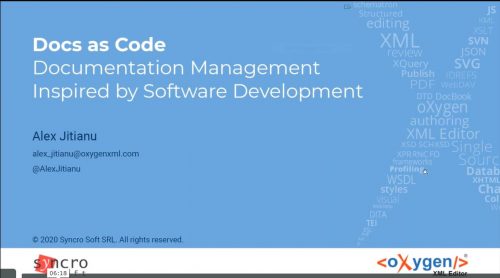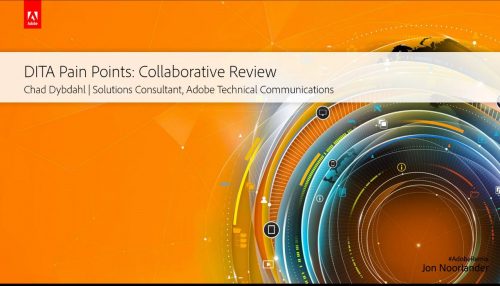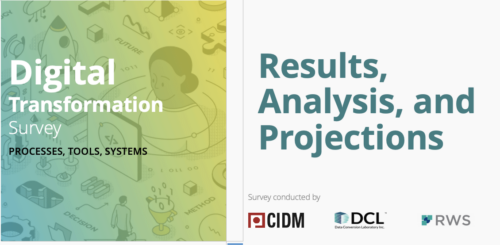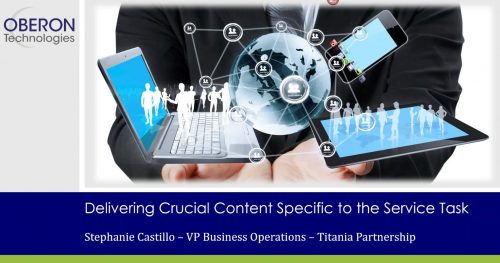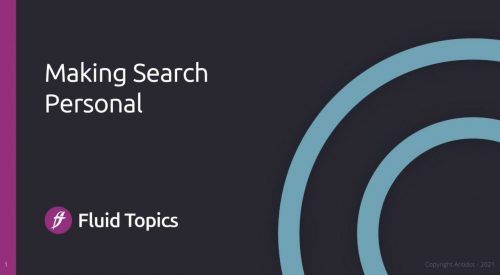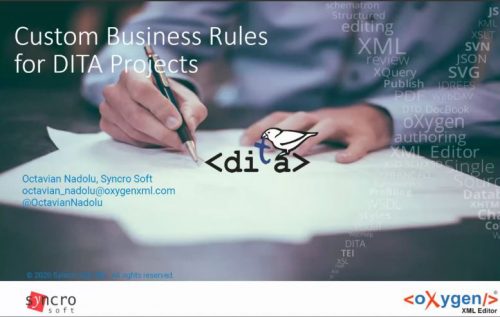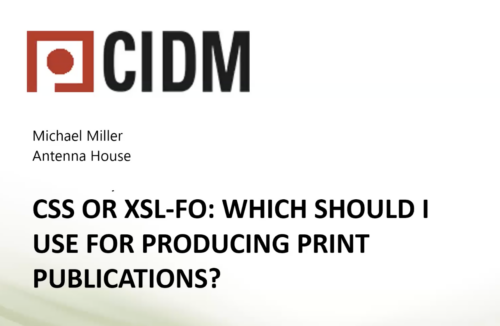-
February 5, 2020 If you are implementing a large-scale infrastructure project such as a cCMS implementation or migration to DITA at your organization, then you know about predictable costs such as purchasing hardware, licensing software, and training writers. Predictable expenses are easy to manage and plan for as you know when they will be due, and at least approximately how much they are going to cost. There are, however, other potential costs that may be unknown, either because your requirements have iterated since the original project scope was defined or you have uncovered something unexpected in your environment. These unpredictable expenses can add risk to the overall project timeline or impact the actual cost. They may be challenging to fit into your existing plan or require additional planning. In this webinar, Sabine Ocker will discuss some top hidden costs and provide insights on how to identify, plan for, and mitigate the impact of common examples such as changes to project scope, lack of appropriate standards, and content conversions. Presented by: Sabine Ocker has 20 plus years’ experience helping companies solve their interesting business problems. Solutions have included DITA migrations, content conversions, new tools or CMS, information modeling, content strategy, multi-channel publishing, and taxonomy development.
-
October 21, 2020 Thinking of automating your entire conversion process to DITA? Wanting to handle conversion work manually, in-house? Before you proceed, think about how the conversion could help you derive the benefits of DITA that you expect. A simplistic approach may allow you to publish something that looks just like what you have now. But a really good quality conversion will help you to leverage content reuse, personalization and multi-channel publishing, as well as making it easier to maintain and update your content. For example, will your conversion generate keys and keyrefs for variables? How about a relationship table, to prevent broken links? Will menu cascades be correctly marked up, for localization purposes? Presented by: Helen joined Stilo as a technical editor. She now works closely with Stilo Migrate customers, helping them to analyze their legacy content and configure appropriate mapping rules. She also provides Migrate customer training and support. Helen has helped Migrate customers to convert tens of thousands of pages of content to DITA and custom XML. Helen holds a Bachelor of Arts in English from St. Francis Xavier University in Antigonish, Nova Scotia, and has pursued graduate studies at Queen’s University in Kingston, Ontario.
-
September 16, 2020 Tools and techniques used in software development can also be applied for documentation management:
- Storage and issue management using GitHub
- Automated quality checks and continuous publishing using Netlify
- Editing and collaboration support
- Release strategies
-
Date: August 7, 2019 Gathering feedback from subject matter experts and other stakeholders is frequently a source of frustration for both content developers and SMEs alike. Whether you use the old “red pen” technique or circulate PDFs to your SMEs for comment and review, incorporating that feedback into your source content is time-consuming, labor-intensive, and error prone – not to mention difficult to track over time. In this webinar Chad Dybdahl, Adobe Solutions Consultant, will walk you through a highly collaborative workflow experience that allows you to:
- Easily collect feedback from many stakeholders simultaneously, in real-time
- Quickly import changes from reviewers back into your DITA source content
- Accept and reject whose changes
- Preserve trackability of the changes throughout the content lifecycle
-
Recorded on: March 27, 2024

DITA is a fantastic tool for authoring efficiency and content management. It might as well be the keystone for outstanding content experiences, like content personalization and multi-channel delivery. But caution! What was thought for content creation is not always the right fit for modern content publishing.
Drawing from his experience as a content expert and senior consultant at Fluid Topics, Gaspard Bébié-Valérian will address in this webinar the specifics for content delivery of two key elements, metadata and granularity, and how to enrich and optimize them to build exceptional experiences with your DITA content.
Don’t miss the opportunity to delve into practical use cases encountered during real-life implementations and gain insights to enrich your own content strategy."
Presented by Gaspard Bébié-Valérian At the crossroads of engineering and social sciences, Gaspard enjoys exploring the breadth of technologies involved in technical documentation, including structured documentation, CCMS, and DITA-OT. Gaspard works as content expert and senior consultant at Fluid Topics, helping clients get the most out of their Content Delivery Platform.
At the crossroads of engineering and social sciences, Gaspard enjoys exploring the breadth of technologies involved in technical documentation, including structured documentation, CCMS, and DITA-OT. Gaspard works as content expert and senior consultant at Fluid Topics, helping clients get the most out of their Content Delivery Platform. -
Recorded: August 25, 2022


 Digital Transformation is often defined as the process of using digital technologies to create or optimize business processes to improve company and customer experience and meet changing customer demand and market requirements.
Digital transformation may involve spending thousands, hundreds of thousands, or even millions of dollars purchasing new tools and technologies. No matter how many new tools and systems and how much money you put toward transforming your organization, a large piece of the digital transformation puzzle comprises a content transformation.
CIDM, DCL, and RWS wanted to understand what steps people are taking toward “digital transformation” and where content structure and information architecture fit into the plan. The three organizations launched a three-month long “Digital Transformation Survey” to understand how various industries address the adoption of processes, technology, tools, and information architecture.
The results have been collected, analyzed, and discussed. Now it’s time to share the results and our observations with you. No matter what industry you work in, digital transformation is happening on many levels, and understanding how your peers are applying resources, budget, and strategies can contribute to your success.
Presented by:
Digital Transformation is often defined as the process of using digital technologies to create or optimize business processes to improve company and customer experience and meet changing customer demand and market requirements.
Digital transformation may involve spending thousands, hundreds of thousands, or even millions of dollars purchasing new tools and technologies. No matter how many new tools and systems and how much money you put toward transforming your organization, a large piece of the digital transformation puzzle comprises a content transformation.
CIDM, DCL, and RWS wanted to understand what steps people are taking toward “digital transformation” and where content structure and information architecture fit into the plan. The three organizations launched a three-month long “Digital Transformation Survey” to understand how various industries address the adoption of processes, technology, tools, and information architecture.
The results have been collected, analyzed, and discussed. Now it’s time to share the results and our observations with you. No matter what industry you work in, digital transformation is happening on many levels, and understanding how your peers are applying resources, budget, and strategies can contribute to your success.
Presented by:
 Dawn Stevens, President, Comtech Services and Director of CIDM has 28 years of practical experience in virtually every role within a documentation and training department, including project management, instructional design, writing, editing, and multimedia programming. Dawn is the perfect advisor to identify and remove the challenges you face in producing usable, technical information and training content. With both engineering and technical communication degrees, Dawn combines her solid technical foundation with strong writing and design skills to lead our team of consultants and specialists in providing the expertise you need.
Dawn Stevens, President, Comtech Services and Director of CIDM has 28 years of practical experience in virtually every role within a documentation and training department, including project management, instructional design, writing, editing, and multimedia programming. Dawn is the perfect advisor to identify and remove the challenges you face in producing usable, technical information and training content. With both engineering and technical communication degrees, Dawn combines her solid technical foundation with strong writing and design skills to lead our team of consultants and specialists in providing the expertise you need.
 Mark Gross, President, Data Conversion Laboratory, is a recognized authority on XML implementation and document conversion. Mark also serves as Project Executive, with overall responsibility for resource management and planning. Prior to joining DCL in 1981, Mark was with the consulting practice of Arthur Young & Co. Mark has a BS in Engineering from Columbia University and an MBA from New York University. He has also taught at the New York University Graduate School of Business, the New School, and Pace University. He is a frequent speaker on the topic of automated conversions to XML and SGML.
Mark Gross, President, Data Conversion Laboratory, is a recognized authority on XML implementation and document conversion. Mark also serves as Project Executive, with overall responsibility for resource management and planning. Prior to joining DCL in 1981, Mark was with the consulting practice of Arthur Young & Co. Mark has a BS in Engineering from Columbia University and an MBA from New York University. He has also taught at the New York University Graduate School of Business, the New School, and Pace University. He is a frequent speaker on the topic of automated conversions to XML and SGML.
 Chip Gettinger is the VP of Global Solutions Consulting at RWS, he manages a team that works with customers in maximizing global content with RWS. He has experience working with customers to develop global content strategies, business ROI adoption drivers, change management, and technology adoption for component content management systems. He speaks and blogs about customer successes working closely with industry standards, partners, and customers in technology solutions and deployments.
Chip Gettinger is the VP of Global Solutions Consulting at RWS, he manages a team that works with customers in maximizing global content with RWS. He has experience working with customers to develop global content strategies, business ROI adoption drivers, change management, and technology adoption for component content management systems. He speaks and blogs about customer successes working closely with industry standards, partners, and customers in technology solutions and deployments. -
June 5, 2019 In today’s market, companies with service organizations are responsible for contributing 30%+ to overall company profit. While much of the effort in the last five years has gone into automating task management for Service Managers and technicians, a large gap remains in the way service organizations effectively find, use, and capture critical content specific to the task. Service Information Delivery solves the age-old struggle of providing accurate and relevant content to field service personnel as the task or job is being performed. It also captures and shares data during the process and provides audit trail and analytics upon completion. All critical functions to help the Service organization perform at the highest level within the business. Attendees will learn: 1. What is Service Information Delivery? 2. Why Service information delivery is critical in today’s business environment? 3. How can this impact the overall Service business and bottom line? Presented by: Stephanie Castillo is VP Business Operations – Titania Partnership, a leading provider of expert services and software. For more than 20 years Stephanie has been managing global documentation initiatives and writing teams for global organizations. Throughout her career she has architected solutions, managed global implementations, defined processes, and supervised requirements gathering and tools selection projects for multichannel content publishing systems as well as global translation management systems. Stephanie holds an MBA from Cardinal Stritch University, BA in communications from University of Wisconsin. In her free time she enjoys spending time with her daughter and husband, running and playing soccer.
-
May 26, 2021 What if the search function on your tech doc was providing personalized results and was as good as Google, reading the mind of your users and anticipating their needs? What about a search engine that learns and gets more accurate, more relevant and personal every day. What does it take to get there? It’s mostly about technology, but not only. It also requires information: about your content (metadata) and about your users (profiles). In this Webinar, we will introduce the challenges, review the possible solutions, and discuss what you need to have and do in order to support this shift to a modern user experience. Presented by: Fabrice Lacroix is a serial entrepreneur and a technology pioneer. He has been working for 25 years on the development of innovative solutions around search technology, content enrichment and AI. He is the founder of Fluid Topics, the leading Content Delivery Platform that reinvents how users search, read and interact with technical documentation.
-
Recorded on: February 8, 2024
 Presented by: André Schlotz, RWS; Hareesh K, Sandvik Mining and Construction GmbH; and Harald Stadlbauer, MD, NINEFEBLearn how Sandvik Mining and Construction makes their DITA-based technical content fit to support their global servitization strategy. For many years Sandvik is creating, managing, translating, and publishing conditionalized DITA content with RWS technology and services. This content has been created with a “Safety First” approach and published as PDFs. Sandvik`s new digital service offerings – enabled through connected products - require customers and service technicians to retrieve personalized and relevant information components through their Web-based aftersales application My Sandvik / SmartMate with the new paradigm: provide the right information, for the right use case at the right time. To enable this a semantic data layer has been implemented combining existing taxonomies, product-structures and iiRDS. DITA topics are now tagged by taking advantage of the Semantic AI capabilities – so called “Smart Tagging”. The hereby created smart content components are then delivered and exposed in a content-as-a-service approach.
Presented by: André Schlotz, RWS; Hareesh K, Sandvik Mining and Construction GmbH; and Harald Stadlbauer, MD, NINEFEBLearn how Sandvik Mining and Construction makes their DITA-based technical content fit to support their global servitization strategy. For many years Sandvik is creating, managing, translating, and publishing conditionalized DITA content with RWS technology and services. This content has been created with a “Safety First” approach and published as PDFs. Sandvik`s new digital service offerings – enabled through connected products - require customers and service technicians to retrieve personalized and relevant information components through their Web-based aftersales application My Sandvik / SmartMate with the new paradigm: provide the right information, for the right use case at the right time. To enable this a semantic data layer has been implemented combining existing taxonomies, product-structures and iiRDS. DITA topics are now tagged by taking advantage of the Semantic AI capabilities – so called “Smart Tagging”. The hereby created smart content components are then delivered and exposed in a content-as-a-service approach.
André Schlotz is VP Global Automotive and Manufacturing Solutions, RWS Group. He helps organizations to digitalize their content supply chain through structured content authoring, component content management and single source content delivery. Before joining RWS in 2013 he was holding various management positions in manufacturing companies in product development, aftersales, process organization and IT. He has more than 20 years of experiences in process consulting, planning, building and running digital industry solutions.
 Hareesh Kanakaswamy is the Portfolio Manager of Digital Services Solutions at Sandvik Mining and Construction G.m.b.H. With 14+ years of experience in product development and aftermarket operations, he specializes in constructing end-to-end digital ecosystems for servitization strategies. Hareesh is a firm believer in innovation as the key to sustainable progress for humanity.
Hareesh Kanakaswamy is the Portfolio Manager of Digital Services Solutions at Sandvik Mining and Construction G.m.b.H. With 14+ years of experience in product development and aftermarket operations, he specializes in constructing end-to-end digital ecosystems for servitization strategies. Hareesh is a firm believer in innovation as the key to sustainable progress for humanity.
 Harald Stadlbauer, MD is General Manager of the NINEFEB Group of companies, dedicated to the advancement of Technical Communication, like Technical Documentation as well as eLearning to the intelligent delivery of it. He is actively engaged in developing iiRDS further as well as contributing to the AAS (Asset Administration Shell) sub-models of the IDTA (Industrial Digital Twin Association)
Harald Stadlbauer, MD is General Manager of the NINEFEB Group of companies, dedicated to the advancement of Technical Communication, like Technical Documentation as well as eLearning to the intelligent delivery of it. He is actively engaged in developing iiRDS further as well as contributing to the AAS (Asset Administration Shell) sub-models of the IDTA (Industrial Digital Twin Association)
-
December 16, 2020 A step by step guide to getting started with Schematron and Schematron Quick Fixes. Schematron and Schematron QuickFix (SQF) languages can be used to improve efficiency and quality when editing DITA documents. You can define actions that will add complex structure in your documents, or make modifications in multiple places or actions that will convert a structure into another. These changes are made by keeping the document structure valid and conforming to your project specification and will help the content writer add content more easily and without making mistakes. Join us to see:
- How to create business rules with Schematron
- How Schematron rules are applied
- How to apply specific Schematron rules on all DITA files
- How to develop Schematron Quick Fixes to make it very easy to solve the reported problems
-
Recorded on June 8, 2023

In this webinar, you will learn about the two recognized international standards available to address the fully automated formatting of pages and publications for PDF and print: CSS and XSL-FO. We will explore the two standards and address:
- When you should use automated document formatting versus desktop publishing
- The motivations for and benefits of automated document formatting
- The challenges
- Where CSS and XSL-FO fit within solutions for the overall delivery of formatted pages and publications

Michael Miller is Vice President of Antenna House, Inc., a company that has developed one of the leading standards‐based (XSL‐FO and CSS) document formatting software products on the market today. Michael has a degree in Printing Engineering and Management and has been involved in high‐end composition, document formatting, and document management for over 40 years. He has an extensive background with structured data, including SGML, XML, S1000D, and DITA. During his career, he has worked in Europe and North America and has been involved in the implementations of some of the largest fully automated publishing and document formatting projects.
-
August 10, 2020 Content developers and managers worldwide are coming together to share ideas and inspire each other at ConVEx in September. When first announced, we said ConVEx is not an online simulation of an in-person conference, but an immersive experience designed from the ground up to use our e-resources in the best possible way to bring you a wealth of ideas and information to support your efforts in defining and executing a comprehensive content strategy. During this Webinar, Dawn Stevens explains what we mean by this statement and what you can expect and gain from this new event format. We'll discuss the event format, the technology we'll use, and highlight the many networking activities provided. By the end of the Webinar, you'll know why you should attend ConVEx — it's an opportunity to have a positive experience, converge with others in the industry, focus your attention on industry issues, and magnify your value to your organization. Presented by: Dawn Stevens, President, Comtech Services and Director of CIDM has 28 years of practical experience in virtually every role within a documentation and training department, including project management, instructional design, writing, editing, and multimedia programming. Dawn is the perfect advisor to identify and remove the challenges you face in producing usable, technical information and training content. With both engineering and technical communication degrees, Dawn combines her solid technical foundation with strong writing and design skills to lead our team of consultants and specialists in providing the expertise you need.

